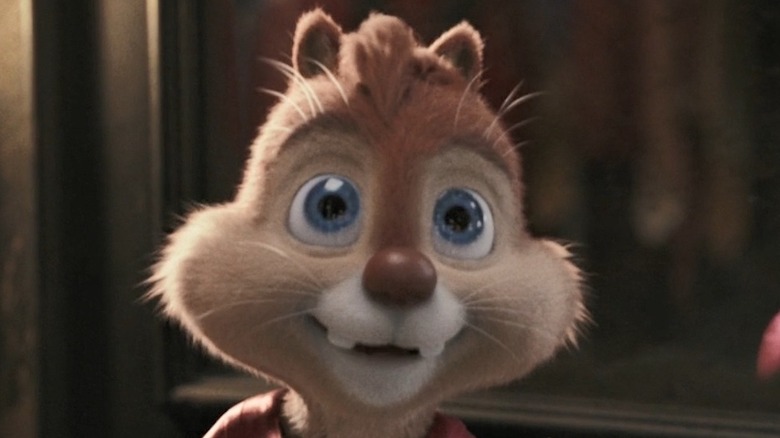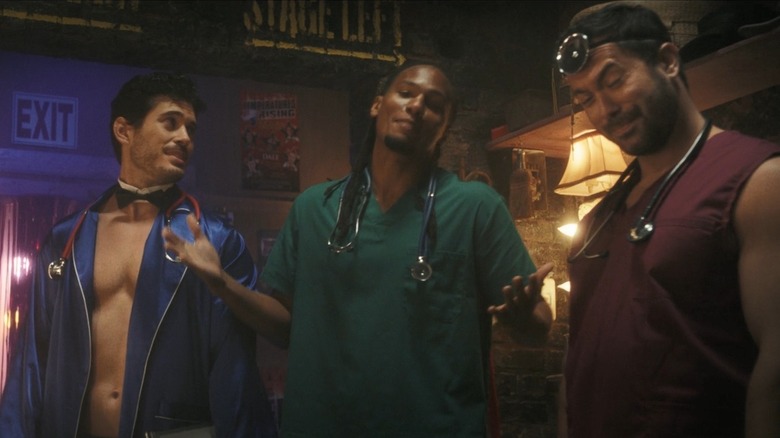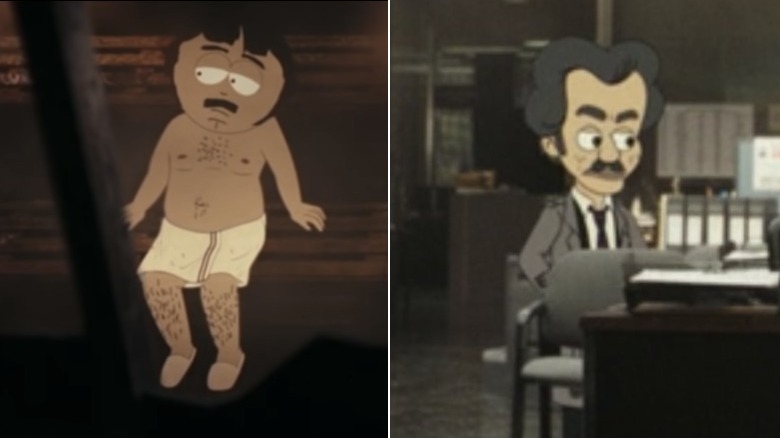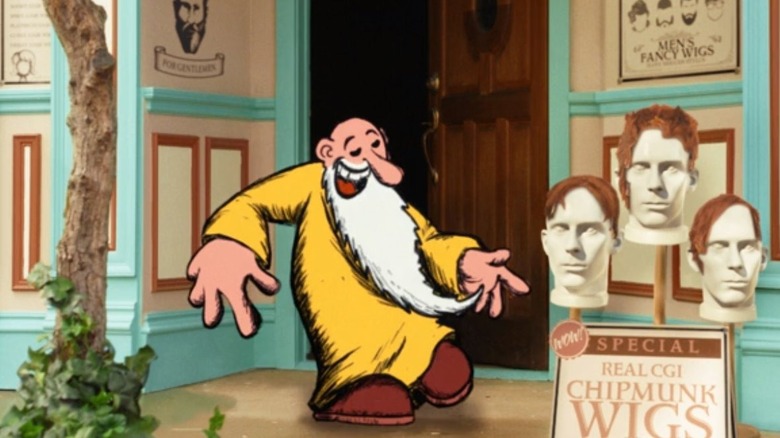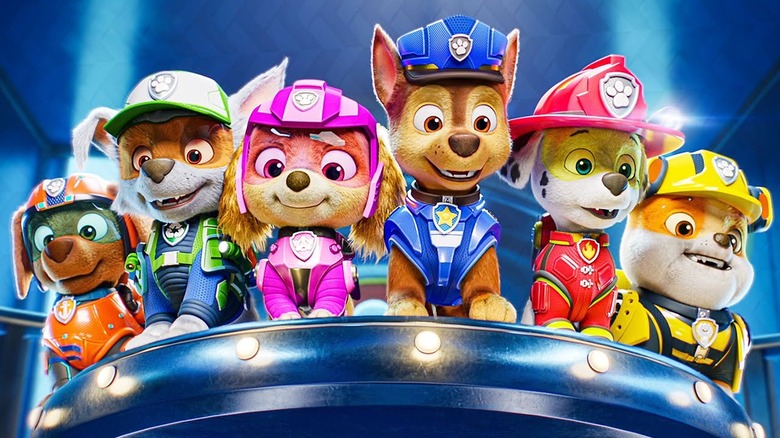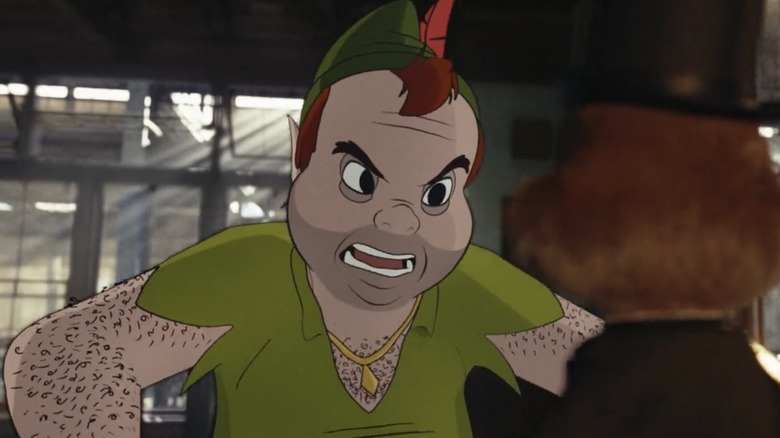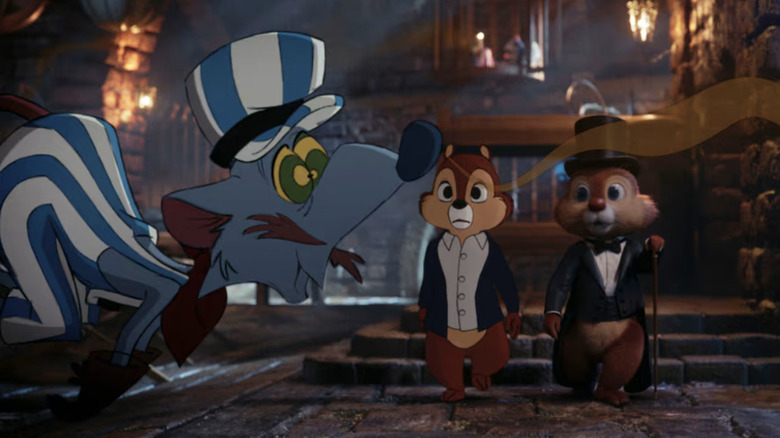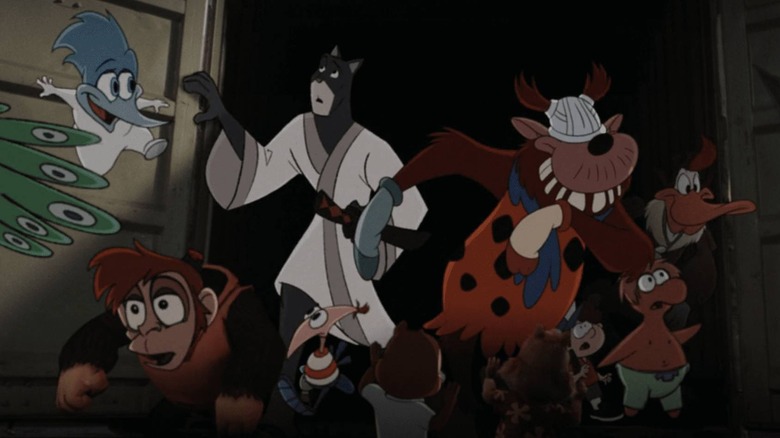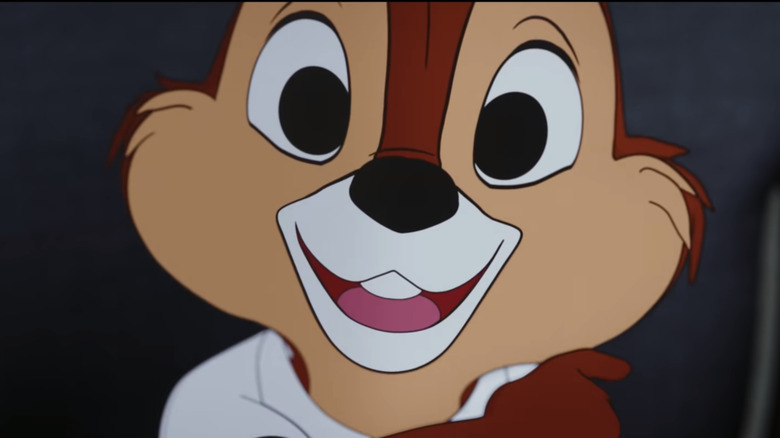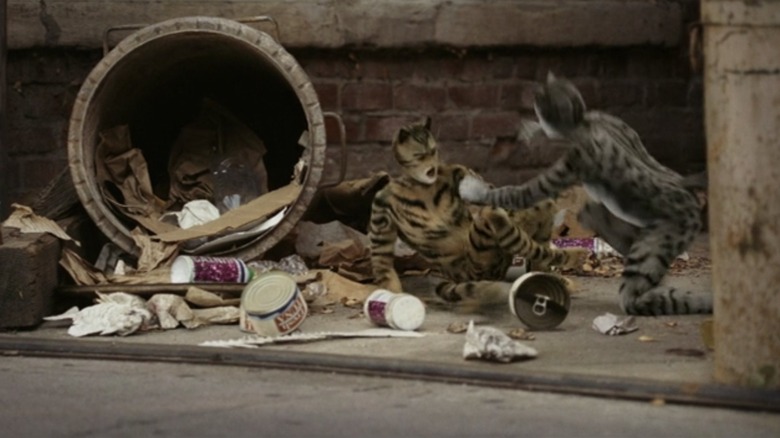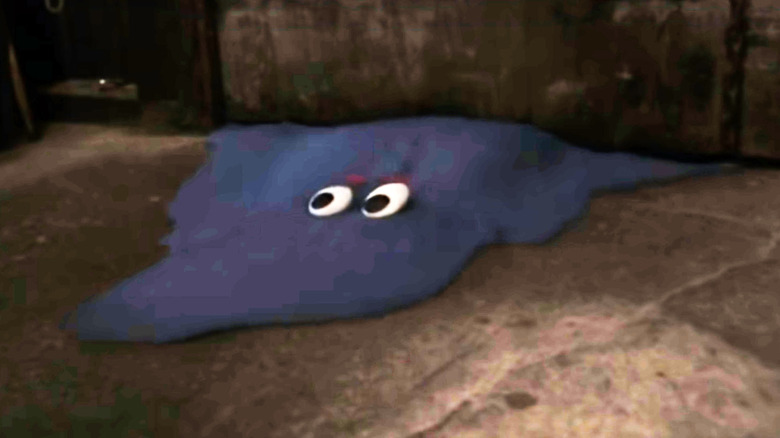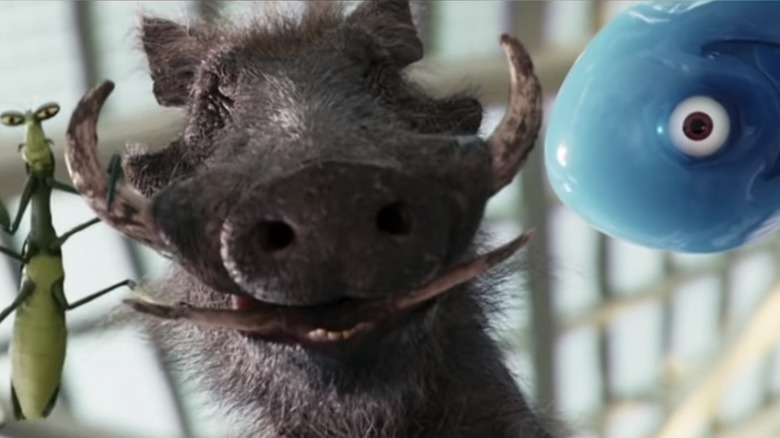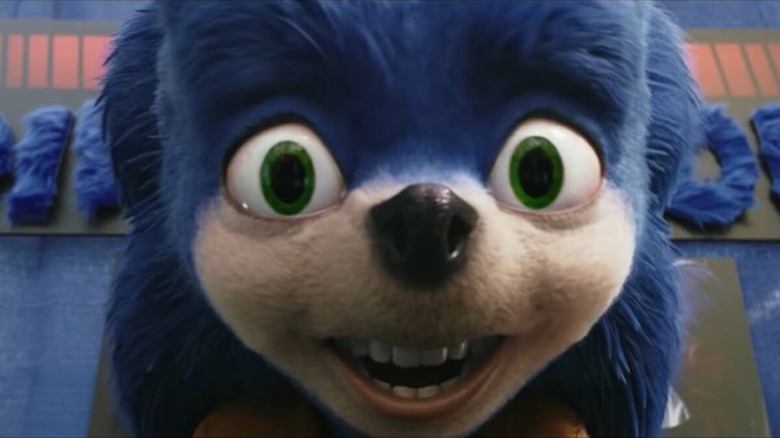Things In Chip 'N Dale Rescue Rangers You Only Notice As An Adult
Disney films tend to offer something for parents to enjoy alongside their kids, and Disney's assorted live-action remakes market themselves very heavily on older viewers' nostalgia. Even by these standards, however, the new live-action/animation hybrid "Chip 'n Dale: Rescue Rangers" movie, streaming on Disney+, is surprising in that it feels like it's actually designed more for adults' entertainment than it is for the entertainment of younger viewers.
Perhaps this shouldn't be too surprising, considering it's directed by Akiva Schaffer and starring Andy Samberg, both of The Lonely Island fame. The similarities in its set-up to the decidedly adult-oriented "Who Framed Roger Rabbit?" should have also been a hint as to what the movie would entail. From PG rating-pushing dirty jokes parents will hope will fly over the kids' heads to clever social commentary and Hollywood insider references, the following moments in the "Chip 'n Dale: Rescue Rangers" movie make for a funnier and edgier experience than one might expect from a Saturday morning cartoon reboot.
Chippendales references
When people hear the phrase "Chip 'n Dale," what do they think of first? The opening narration of the "Chip 'n Dale: Rescue Rangers" movie initially jokes that first thing that comes to mind is the 18th century cabinet-maker Thomas Chippendale, before slyly acknowledging what most adults in the audience are actually thinking: the Chippendales male strippers. A photo of Chippendales dancers is shown, with the narration referring to "these guys." The cartoon chipmunks come third in the ranking of associations.
If this immediate reference to Chippendales isn't enough, the film takes the joke further by revealing that the "play" Dale has been bragging about working on is heavily implied to be a Chippendales-style strip show. Schaffer describes this particular adult humor as "right on the line of what would be acceptable." It acknowledges something a lot of adult viewers will be thinking while (hopefully) safely going over kid viewers' heads.
Adult cartoon cameos
In the style of "Who Framed Roger Rabbit?" "Chip 'n Dale: Rescue Rangers" features a boatload of cartoon character cameos from various different animation studios. One of the most surprising things about the movie is just how many of these cameos come from cartoons that parents generally wouldn't want their kids watching.
Randy Marsh from "South Park" shows up in a Russian bathhouse, for example. Advertisements tell people to vote for "Senator Butthead," the character from Mike Judge's infamous MTV series "Beavis and Butt-head." Detective Florez from Netflix's "Big Mouth" shows up at the police headquarters (note: his presence in the film likely has to do with being voiced by John Mulaney, who also voices Chip in this movie). While Rick and Morty don't show up directly, as they do in "Space Jam: A New Legacy," the Adult Swim hit also gets some recognition here via a Pickle Rick cosplayer and CGI editing images of Chip and Dale in the style of "Rick and Morty."
R. Crumb meets Disney
Including adult animation characters in a PG-rated Disney movie is surprising enough, but it's a real shock to see an adults-only underground comix character show up in "Chip 'n Dale: Rescue Rangers." Mr. Natural, the wacky mystical guru character created by underground cartoonist Robert Crumb, has never shown up in animation like the other cameo characters in the movie have, so his cameo would have been unpredictable even if R. Crumb wasn't the last artist you'd ever associate with Disney.
Crumb was a major figure in the underground comix movement of the 1960s and '70s, in which independent cartoonists bypassed the Comics Code Authority entirely to publish anti-commercial X-rated countercultural satires. Mr. Natural has been described as being perhaps the only likable character in all of Crumb's oeuvre. In "Chip 'n Dale: Rescue Rangers," he's one of the toons operating on the black market on Main Street and is voiced by Schaffer.
Paw Patrol gets violent
For all the adult cartoon characters who show up in "Chip 'n Dale: Rescue Rangers," the movie's raunchiest joke happens to be one centered around a cartoon intended for preschoolers. It's when Ellie tells the story of why Police Captain Putty doesn't trust her, saying, "Last year, when Peppa Pig went missing, I fell for a bogus tip and made the whole squad raid Nickelodeon Junior Studios. And the toons fought back. Paw Patrol attacked Sergeant Henderson. The doctors say he'll never have kids."
Putting the Paw Patrol in a violent fight with an actual police force is certainly a new take on the now-ubiquitous jokes about "Paw Patrol" as police propaganda. Implying at least one member of Paw Patrol got so violent as to seemingly castrate a man is both darkly hilarious and downright gasp-inducing as a joke in a family film. The story gets a callback later on when Putty jokes, "I hope we don't get attacked by the Rugrats this time."
How Hollywood treats child stars
One of the more controversial parts of "Chip 'n Dale: Rescue Rangers" involves the central villain "Sweet Pete" — a middle-aged, out-of-shape Peter Pan (voiced by Will Arnett). His backstory in the movie is that, once the animated actor playing "the boy who never grew up" hit puberty, nobody in Hollywood wanted anything to do with him (it's never really explained why some cartoon characters age in this movie while others don't).
It's possible this was meant as a generalized commentary on the way child stars have been historically mistreated in Hollywood. Some viewers, however, have felt extra uncomfortable with this characterization due to similarities with the story of Bobby Driscoll, the actor who voiced Peter Pan in the original 1953 film. Driscoll's contract with Disney was dropped the same year that "Peter Pan" was released, and the former child star struggled with drugs and crime before dying in 1968 at age 31.
If you or anyone you know is struggling with addiction issues, help is available. Visit the Substance Abuse and Mental Health Services Administration website or contact SAMHSA's National Helpline at 1-800-662-HELP (4357).
Stinky cheese as drugs
The "Chip 'n Dale: Rescue Rangers" movie is a separate entity from the old TV series; you could pretty much pull off the film's premise with any half-forgotten late '80s/early '90s cartoon. However, one bit of characterization that carries over directly from the source material is Monterey Jack's absolute addiction to stinky cheese. Jack's in debt to the Valley Gang due to his addiction, and when he gets kidnapped, Chip and Dale decide to investigate his cheese dealer, the Swedish Chef-esque puppet Bjornson the Cheesemonger.
Kids will laugh at the cartoony visuals of mice floating through the air along stink lines, but older viewers will get the full context of stinky cheese being treated like hard drugs. Bjornson's black market cheese shop is presented like an opium den, presenting a sense of adult danger and menace in a package that can still pass as part of a PG family film.
Bootlegging
The plot of the "Chip 'n Dale: Rescue Rangers" movies centers around various cartoon characters being kidnapped and "bootlegged" — turned into off-brand versions of themselves to appear in lousy rip-offs. This is parodying the likes of GoodTimes Entertainment, Video Brinquedo, Dingo Pictures, and The Asylum, all companies infamous for making horrid direct-to-video movies with titles just similar enough to blockbusters to try and trick confused buyers.
Many of the bootlegged toons appear as hybrids of multiple different characters, which allows for plenty of Easter egg hunting in the scene where the bootlegs are freed. Chip himself is hit by a laser in the bootlegging machine and given a "Snoopy ear" for part of the film. That the process of bootlegging in the film is portrayed as a parallel to human trafficking makes the joke especially dark and may raise some intriguing questions about what exactly is being said in relation to Disney's stringent enforcement and regular extensions of copyright.
Coercive Insurance
While Dale is working the convention circuit, showing off his new CGI surgery on social media, and working at Chippendales, Chip has abandoned show business entirely due to his feelings of betrayal by his former co-star. Instead, he has entered into a more depressing career: selling insurance. Similar to Bob Parr's post-superhero job in "The Incredibles," the insurance business is a clear shorthand for adult viewers that things aren't going the way our protagonist has planned.
The name of the company Chip works for, Coercive Insurance is a joke filled with just the right level of spite at the much-maligned insurance industry. Many of Chip's co-workers appear to be low-budget CG animals, invoking such commercial mascots as the GEICO gecko and the Aflac duck. Sad as this situation may be, Chip seems to be very good at his job, having won several boxes worth of "Employee of the Month" awards.
The Uncanny Valley
In psychology, "the uncanny valley" refers to the phenomenon wherein robots, computer-animated characters, or other humanoid likenesses reach a point where they almost look like the real thing but have enough glaring flaws to make that realism creepy. In "Chip 'n Dale: Rescue Rangers," The Uncanny Valley is an actual place where these creepy CG toons live, "where everything looked real, but nothing looked right." This setting allows for some of the funniest inside jokes in the film.
Amongst the bizarre characters living in the Uncanny Valley, particularly noteworthy ones include a couple of cats from the infamous 2019 "Cats" movie and Bob the Dwarf, a Seth Rogen-voiced motion-capture character who could have stepped straight out of Robert Zemeckis' 2007 "Beowulf" movie. Bob's inability to move his eyes, one of the main flaws of early motion-capture films like "The Polar Express," is the subject of many jokes throughout the movie.
Claymation Terminator 2 homage
Beyond just animation references, "Chip 'n Dale: Rescue Rangers" contains many references to live-action blockbusters. These include including a "Jurassic Park" homage when Sweet Pete bootlegs himself into a monster, multiple jokes about "The Fast and the Furious" series, and a "Batman v. Superman: Dawn of Justice" parody wherein the Caped Crusader fights... E.T. from "E.T.: The Extra-Terrestrial." All these jokes are about PG and PG-13 films which kids likely have at least some familiarity with, but one of the most significant live-action movie references is to an R-rated blockbuster: "Terminator 2: Judgement Day."
The villain of "T2," the T-1000, is an android made of liquid metal, capable of dissolving itself and reforming. Captain Putty, the "secret" villain of "Chip 'n Dale: Rescue Rangers," dissolves himself to slide through doors in a similar way, only he does so by being made of clay rather than liquid metal. The theme music from "T2" plays during this scene. Both Putty and the T-1000 are also defeated in the same way: being frozen and smashed.
A surprisingly metal soundtrack
Right in its opening scene, "Chip 'n Dale: Rescue Rangers" establishes it aims a bit more adult than the typical children's movie with its musical selection of "Friendship" by Tenacious D. The song itself is cute enough to fit the opening montage of the two chipmunks' childhood friendship, but Tenacious D, a comedy rock/metal band consisting of Jack Black and Kyle Gass, is a group known for absurdly explicit content. The version of the song in the movie uses cleaned-up lyrics, but needle-dropping the D nonetheless establishes the film's edgy alt-comedy bonafides.
Further musical selections indicate there must have been some serious metalheads involved in the production. When Chip walks home and takes off his earbuds, for example, viewers briefly hear the lyrics "Console yourself, you're better alone!" from the song "Laid to Rest" by Lamb of God. Of all the bands you might expect to lend their music to a Disney+ release, Lamb of God surely doesn't rank high on that list.
Into the Seth Rogen-verse
The convention sequences allow "Chip 'n Dale: Rescue Rangers" to go all-in on character crossovers. One of the most memorable is a chance encounter between four different animated characters voiced by Seth Rogen. Bob the Dwarf gets tackled by Pumbaa from the 2019 "Lion King" remake, who stares at Bob's "weird dead eyes" and laughs in that iconic Seth Rogen chuckle. Two of Rogen's DreamWorks Animation characters, Mantis from "Kung Fu Panda" and B.O.B. from "Monsters vs. Aliens," join in on the laughter and "weird eyes" comments.
This gag is amusing both for the sheer Seth Rogen-iness of it all and for the "pot calling the kettle black" humor of these particular characters being weirded out by Bob the Dwarf's eyes. "The Lion King" remake is a film that itself has been criticized for "uncanny valley" animation. The two DreamWorks characters are more appealingly cartoony than photorealistic Pumbaa, but they have their own "weird eye" stuff going on: Mantis is a bug with eyes bulging out the sides of his head while B.O.B. is a gelatinous cyclops.
Ugly Sonic
This is topical reference both recent enough and highly publicized and joked about enough that there's a good chance older kids actually will get this one, but it's still insider-y enough (not to mention hilarious enough) to put on this list of things adults are most likely to fully appreciate. Yes, that horrifying, tooth-filled original design for Sonic in the "Sonic the Hedgehog" is back in "Chip 'n Dale: Rescue Rangers," voiced by Tim Robinson from "I Think You Should Leave."
"Ugly Sonic," as he calls himself in the film, a distinct character from the normal Sonic — where normal Sonic "gotta go fast," Ugly Sonic "gotta go slow." Unlike so many other characters who appear as brief cameos, Ugly Sonic actually plays a significant role in the film's story, showing up at two different pop culture convention scenes and eventually helping save the day alongside the FBI. "Chip 'n Dale: Rescue Rangers" may be making fun of the horrible artistic decision-making that led to the original Ugly Sonic design to begin with, but it also oddly gives the most respect this frightening rodent has ever received.
